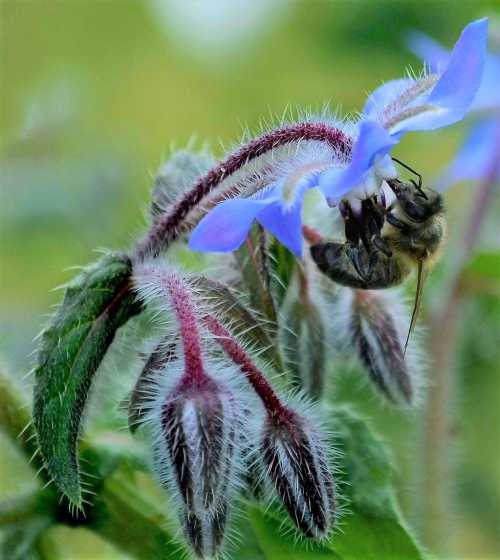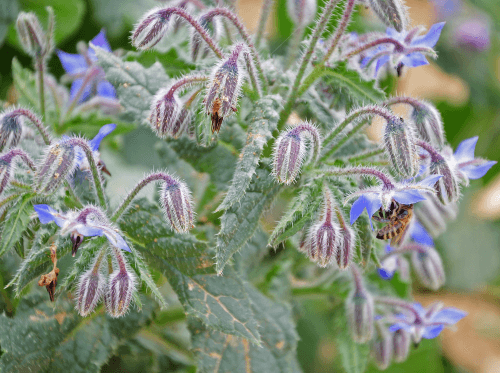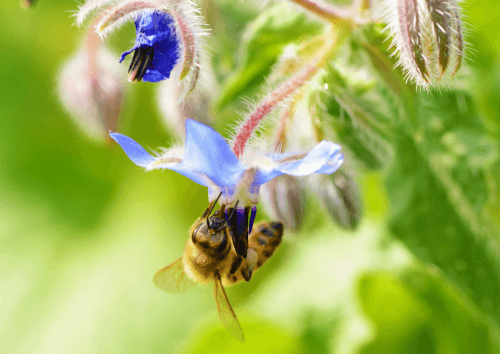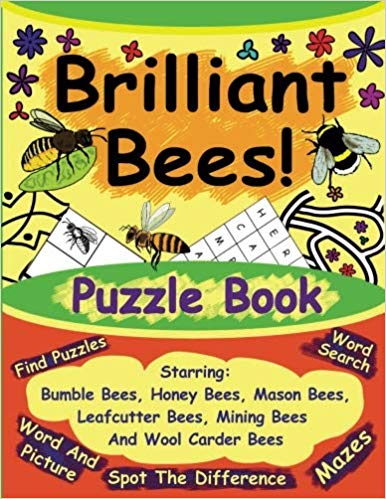Borage For Bees And Pollinators
I was asked, 'Do bees really like borage?' The answer is, yes, most definitely, and borage is not only visited by bees, but other pollinators too.
To prove this point, there is scientific evidence investigating both the variety of bees and pollinators visiting the plant, and the reasons for its attractiveness as a source of food.
Borage For Bees And Pollinators
Also known as 'starflower' this herb is useful to humans as well as bees. The flowers and leaves have culinary value, and the seeds are used to make oil.
If you have ever come across a patch of borage plants (Borago officinalis) in full flower, and watched for a short while, you will more than likely have observed that the flowers were very popular with bees.
You may well have seen quite a few other insects too, including pollinating flies of various types, visiting the pretty blue flowers.
 Bee on borage (Borago officinalis) flower
Bee on borage (Borago officinalis) flower
The reason for its popularity among pollinators, is quite simply that borage provides lots of nectar and pollen. Scientists have even quantified how much this plant provides, and which pollinators benefit.
Why bees and pollinators love borage
A number of studies have included borage in their assessments of pollinator plants, but for the purpose of this page, I'm going to focus on a comprehensive 3 year study conducted in Poland and published in 20191 by Stawiarz et al.
Some of the key findings from the study by Stawiarz et al were as follows:
1. Nectar secretion from borage flowers begins at the loose bud stage and lasts throughout the entire life of the flower.
2. The average number of flowers on a single borage plant was a whopping 953 single flowers! If this sounds unrealistic, do take a look at the image below showing part of a borage plant. These plants are bushy, and have many flower heads.
 Honey bee foraging on a borage plant.
Honey bee foraging on a borage plant.3. The average life of each single borage flower was 21.2 hours, and plants had an average flowering time of 56 days.
4. The table below provides a summary of the nectar and pollen provision of a single borage flower:
| Average offering per single Borage flower | |
|---|---|
| Nectar | 4mg |
| Pollen | 1.1mg |
| Note: A single borage plant had on average 953 single flowers during the flowering season! | |
5. During the growing season, on average, a single borage plant can supply insects with 1.1g of nectar sugars (total sugar content derived from the nectar) and 1.1g of pollen.
6. A single square meter of borage crop can supply on average 5.2g of nectar sugar (total sugar content derived from the nectar) and the same weight of pollen.
In view of the number of flowers per plant, and the excellent offering of nectar and pollen, is no surprise that bees love borage!
Indeed, honey bee hives cited on borage fields produce excellent borage honey.
Which bees and pollinators visit borage?
 Honey bee on a borage flower.
Honey bee on a borage flower.The research by Stawiarz et al confirmed that borage plants are indeed popular with a range of pollinators.
| Proportion Of Visitors To Borage Flowers | |
|---|---|
| Honey bees (Apis mellifera) | 29.50% |
| Bumble bees (Bombus) | 22.20% |
| Other bee species | 21.40% |
| Flies (Diptera) | 18.50% |
| Other insects | 8.40% |
The authors of the study noted that honey bees observed in the borage flowers primarily exploited the nectar and less readily the pollen.
In contrast, the pollen provided by borage is readily collected by bumble bee species, especially Bombus terrestris (buff-tailed bumble bee) and Bombus lucorum (White-tailed bumble bee) as confirmed in other research (such as Carvell et al., 20062).
Growing borage for bees
Choose a well-drained, sunny spot for best results (although I have previously grow it in dappled shade).
You can grow this plant easily from seed sown directly into soil in Spring. They have deep roots, so make sure you choose a spot where they can be left to flourish.
Tip:
These plants are annuals and can be dug up at the end of the flowering season and composted - the leaves and stems are great natural-fertilizers for the soil.
References
1. Stawiarz, Ernest, Wróblewska, Anna, Masierowska, Marzena and Sadowska, Dagmara. "Flowering, Forage Value, and Insect Pollination in Borage (Borago Officinalis L.) Cultivated in Se Poland" Journal of Apicultural Science, vol.64, no.1, 2020, pp.77-89. https://doi.org/10.2478/jas-2020-0005.
2. Carvell, C., Westrich, P., Meek, W.R., Pywell, R.F., Nowa-kowski, M. (2006). Assessing the value of annual and perennial forage mixtures for bumblebees by direct observation and pollen analysis. Apidologie, 37(3), 326-340. http://doi.org/10.1051/apido:2006002
Create a
lawn for bees
If you found this page helpful or interesting, I'd really be grateful if you would share it with others - if not this page, perhaps another, such as Gardening For Bees.
Thank you so much :) .

